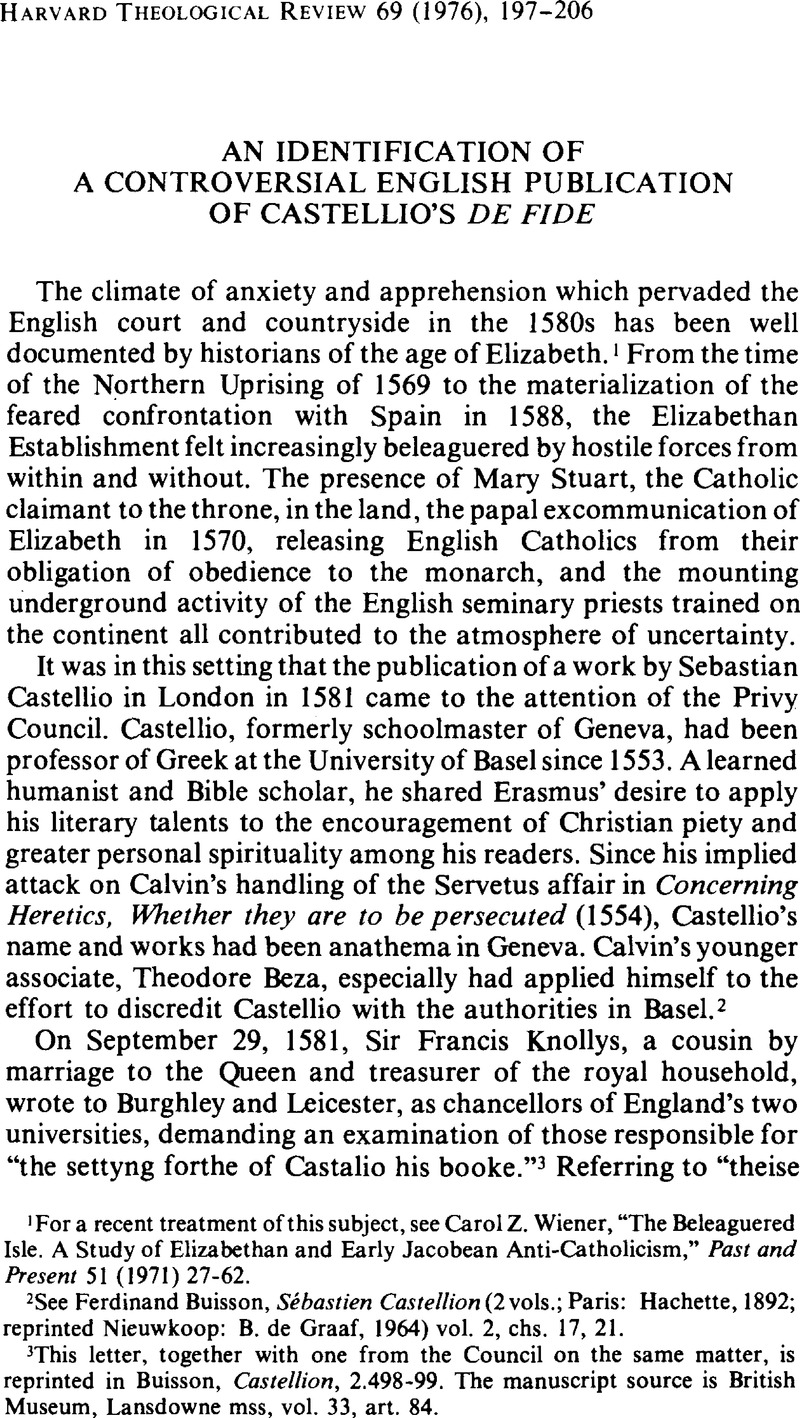Article contents
An Identification of a Controversial English Publication of Castellio's De fide
Published online by Cambridge University Press: 10 June 2011
Abstract

- Type
- Notes and Observations
- Information
- Copyright
- Copyright © President and Fellows of Harvard College 1976
References
1 For a recent treatment of this subject, see Wiener, Carol Z., “The Beleaguered Isle. A Study of Elizabethan and Early Jacobean Anti-Catholicism,” Past and Present 51 (1971) 27–62.CrossRefGoogle Scholar
2 See Buisson, Ferdinand, Sébastien Castellion (2vols.; Paris: Hachette, 1892Google Scholar; reprinted Nieuwkoop: B. de Graaf, 1964) vol. 2, chs. 17, 21.
3 This letter, together with one from the Council on the same matter, is reprinted in Buisson, Castellion, 2.498–99. The manuscript source is British Museum, Lansdowne mss, vol. 33, art. 84.
4 Acts of the Privy Council of England (32 vols.; London: Her Majesty's Stationery Office, 1890–1907) 13.199.Google Scholar
5 I am assuming that the undated letter in Buisson, Castellion, 2.499, referred to in footnote 3 above, was the one resulting from the Council's directive of September 9. The manuscript source is British Museum, Egerton mss, vol. 1693, f. 113.
6 On January 4, 1581, Thomas Purfoot had received a license “under the Bishop of London and Master Coldockes [hand]” to print a book titled De fide vera Christiani. See A Transcript of the Registers of the Company of Stationers of London, 1554–1640 (5 vols.; London: 1875–1877) 2.386.Google Scholar
7 “Sébastien Castellion et l'Angleterre; quelques aspects de son influence,” Bibliothèque d'Humanisme et Renaissance 15 (1953) 15–44.Google Scholar See especially 20–33.
8 The Dialogi sacri went through numerous English printings in the sixteenth century. In 1572 Thomas Marshe received a royal patent to print and sell a number of school books, including the Dialogi sacri. (See Calendar of the Patent Rolls … Elizabeth I. 5.333.) This patent passed to other assignees on his death and finally to the Stationers’ Company in 1605.
9 For further information concerning the two sets of dialogues, see Buisson, Castellion, vol. 1, ch. 6 and vol. 2, ch. 19. The printer responsible for the 1578 edition of the Dialogi IIII is identified by Buisson as Peter Perna of Basel, an Italian exile who published large numbers of Italian Protestant works. I am grateful to St. John's College, Cambridge, for providing me with a microfilm of this work.
10 8.77. In fact, I first discovered this work while checking items dedicated to Bishop Aylmer in Williams, Franklin B., Index of dedications and commendatory verses in English Books before 1641 (London: Bibliographical Society, 1962).Google Scholar
11 Golding, L. T., An Elizabethan Puritan (New York: Richard R. Smith, 1937).Google Scholar
12 This work is reprinted in ibid., 184–98.
13 ibid., 82.
14 Patrick Collinson mentions that Aylmer presided in Grindal's place in the convocation of 1581, which was in session at the very time De fide was apparently presented for licensing. See The Elizabethan Puritan Movement (Berkeley: University of California, 1967) 205.Google Scholar
15 Buisson, Castellion, 2.104–09, 123–32.
16 ibid., 2.173.
17 For a discussion of the differences between Anglican and Puritan theology during this period, see New, John F. H., Anglican and Puritan: the Basis of their Opposition 1558–1640 (Stanford, Cal.: Stanford University, 1964).Google Scholar On this point, see 13–26.
18 Though this is a direct statement (Purfoot edition, STC 4301. B. i. verso), Castellio qualifies it somewhat in a passage to be quoted below.
19 Purfoot edition, STC 4301. C. iiii. verso-C. v. verso.
20 ibid. D. vii. recto-D. viii. recto.
21 ibid. F. iii. recto.
22 This relationship has recently been noted by Ozment, Steven in Mysticism and Dissent, Religious Theology and Social Protest in the Sixteenth Century (New Haven: Yale University, 1973).Google Scholar See especially 189–202, but the observation invites more detailed treatment.
23 Pamp, Frederic E. Jr, has dealt with this subject extensively in his Harvard University dissertation, “Studies in the Origins of English Arminianism,” 1950.Google Scholar
- 1
- Cited by




